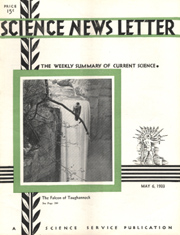From the May 6, 1933, issue

AMERICAS FALCON POSES AGAINST PERFECT BACKGROUND
Rarely is a perfect bird photographed against so perfect a background as the duck hawk, or American falcon, shown on the front cover of this issue of the Science News Letter. The photograph is by Dr. A.A. Allen of Cornell University, and the magnificent cataract plunging in the background is Taughannock Falls, one of the greatest of the scenic beauties of New York State.
To call our duck hawk a falcon is no pretentious effort to thrust a New World parvenu into an Old World aristocracy. The duck hawk is a falcon by right of his own eminent birth, for he belongs to the same species as the peregrine falcon that provided noble sport for the lords and ladies of the Middle Ages. The American bird represents a separate variety, distinguishable mainly by slight differences in feather marking. But the bird of Taughannock Falls is an undoubted falcon, with every right to the proud carriage he displays.
EARTH, LIKE SUN, HAS CORONA, STUDY OF AURORA DEMONSTRATES
Earth, like the sun, has a corona–a luminous gaseous envelope extending far out into space. Its existence has been demonstrated by studies of the aurora borealis, or northern lights, Prof. Lars Vegard of the University of Oslo, Norway, told the American Meteorological Society.
Earths corona, however, shows some marked differences from the suns, Prof. Vegard explained. The suns corona, so far as we know, is generated by the suns own power; Earths is a product of the action of the sun on gases in Earths outer atmosphere. Furthermore, Earths corona is decidedly eccentric, being far more extensive on the side of Earth nearest the sun than it is anywhere else.
Auroral displays, Prof. Vegard said, have been measured at heights of from 70 to 700 or 800 kilometers (43 to 490 or 550 miles) above the surface of Earth. Spectroscopic studies of their light indicate that the glow is due mostly to electrically excited nitrogen gas, which apparently exists at considerable density even at those great heights.
DRS. COMPTON AND MILLIKAN AGREE ON EXPERIEMENTS
Dr. Robert A Millikan and Dr. A.H. Compton, two of the leading experimenters upon cosmic rays, have announced agreement in experimental data gathered by different methods upon separate expeditions.
To the National Academy of Sciences meeting in Washington, Dr. Millikan told how delicate instruments borne aloft by airplanes showed that cosmic rays diminish in hardness or penetrating power at the same rate whether the locality is near the equator or in high latitudes such as in the United States. Dr. Compton reported that his experiments on high mountain peaks in this country and in South America in the tropics showed the same effect.
In other words, both Dr. Millikans and Dr. Comptons experiments can be interpreted by assuming that both photons and particle rays, some of them perhaps the new positron particle discovered last year in Dr. Millikans Pasadena laboratory, are present in the incoming beam.







